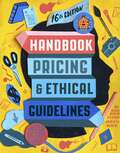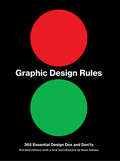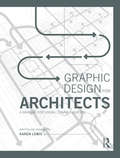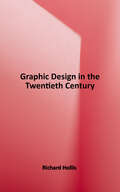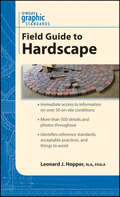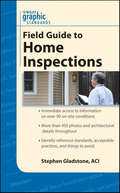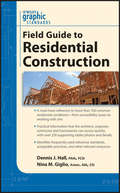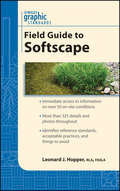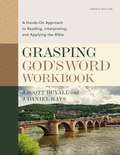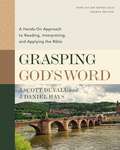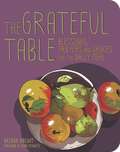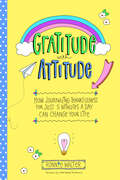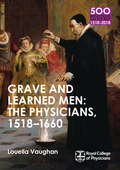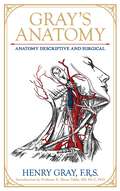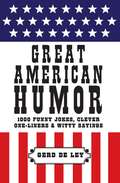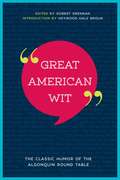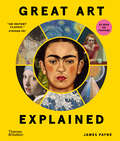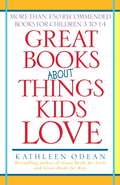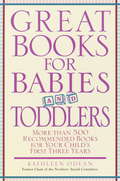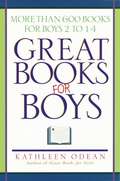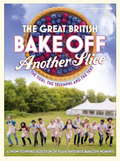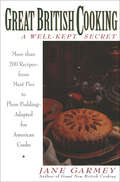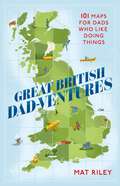- Table View
- List View
Graphic Artists Guild Handbook: Pricing and Ethical Guidelines
by The Graphic Artists GuildThe industry bible for communication design and illustration professionals, with updated information, listings, and pricing guidelines. <p><p> Graphic Artists Guild Handbook is the industry bible for communication design and illustration professionals. A comprehensive reference guide, the Handbook helps graphic artists navigate the world of pricing, collecting payment, and protecting their creative work, with essential advice for growing a freelance business to create a sustainable and rewarding livelihood. <p><p> This sixteenth edition provides excellent, up-to-date guidance, incorporating new information, listings, and pricing guidelines. It offers graphic artists practical tips on how to negotiate the best deals, price their services accurately, and create contracts that protect their rights. Sample contracts and other documents are included. <p><p> For the sixteenth edition, the content has been reorganized, topics have been expanded, and new chapters have been added to create a resource that is more relevant to how graphic artists work today. <p><p> Features include: <p>• More in-depth information for the self-employed on how to price work to make a sustainable living and plan for times of economic uncertainty. <p>• A new chapter on using skills and talents to maximize income with multiple revenue streams—workshops, videos, niche markets, passion projects, selling art, and much more. <p>• Current U.S. salary information and freelance rates by discipline. <p>• Pricing guidelines for buyers and sellers. <p>• Up-to-date copyright registration information. <p>• Model contracts and forms to adapt to your specific needs. <p>• Interviews with eleven self-employed graphic artists who have created successful careers, using many of the practices found in this Handbook.
Graphic Design Rules: 365 Essential Design Dos and Don'ts
by Tony Seddon Sean Adams Peter Dawson John FosterDON'T use comic sans (except ironically!) but DO worship the classic typefaces like Helvetica and Garamond. Graphic Design Rules is a handy guide for professional graphic designers, students, and laymen who incorporate graphic design into their job or small business. Packed with practical advice, this spirited collection of design dos and don'ts takes readers through 365 rules like knowing when to use a modular grid—and when to throw the grid out the window. All designers will appreciate tips and lessons from these highly accomplished authors, who draw on years of experience to help you create good design.
Graphic Design for Architects: A Manual for Visual Communication
by Karen LewisGraphic Design for Architects is a handbook of techniques, explanations and examples of graphic design most relevant to architects. The book covers a variety of scales of graphic design, everything from portfolio design and competition boards, to signage and building super-graphics – to address every phase of architectural production. This book combines and expands on information typically found in graphic design, information design, and architectural graphics books. As architectural communication increases to include more territory and components of a project, it is important for designers to be knowledgeable about the various ways in which to communicate visually. For instance, signage should be designed as part of the process – not something added at the end of a project; and the portfolio is a manifestation of how the designer works, not just an application to sell a design sensibility. In thinking about architecture as a systematic and visual project, the graphic design techniques outlined in this book will help architects process, organize and structure their work through the lens of visual communication. Each chapter is titled and organized by common architectural modes of communication and production. The chapters speak to architects by directly addressing projects and topics relevant to their work, while the information inside each chapter presents graphic design methods to achieve the architects’ work. In this way, readers don’t have to search through graphic design books to figure out what’s relevant to them – this book provides a complete reference of graphic techniques and methods most useful to architects in getting their work done.
Graphic Design in the Twentieth Century: A Concise History (World of Art)
by Richard HollisA new edition of a seminal book on the history of graphic design in the twentieth century by one of the leading authorities in the field. The story of graphic design is one of the most exciting and important developments in twentieth-century visual culture. From its roots in the expansion of printing, graphic design has evolved from a means of identification, information, and promotion to a profession and art in its own right. This authoritative documentary history begins with the poster and goes on to chart the use of text and image in brochures and magazines, advertising, corporate identity, television, and electronic media, and includes the effects of technical innovations such as photography and the computer, as well as the digital revolution. With over eight hundred illustrations fully integrated with the text, this indispensable account is uniquely clear, comprehensive, and absorbing. For this latest edition, Graphic Design in the Twentieth Century has been updated with a new preface and additions to the bibliography, ensuring its continued usefulness to students and designers alike.
Graphic Standards Field Guide to Hardscape
by Leonard J. HopperQuick, reliable answers to your most common on-site questionsWhen you're in the field, you never know what you'll come across. The Graphic Standards Field Guide to Hardscape gives you fast access to the practical information you need when you're on-site and under pressure.Presented in a highly visual and easily portable format, the Field Guide is organized to follow a logical project sequence from site evaluation of existing conditions through construction maintenance. Covering everything from assessing existing conditions, site work, bases and paving, site improvements, and materials, this handy companion conveys the most common answers that landscape architects need in the real world when visiting a construction site, and meeting with architects and engineers or clients and contractors.The Field Guide to Hardscape extends the familiar Landscape Architectural Graphic Standards beyond the office or studio with:Quick access to essential information when away from the studioThings to look for when assessing existing conditions during preliminary design site visits or pre-construction meetingsGraphic Standards--quality details accompanied by real-world photographs of best construction practices and techniquesIllustrations that help you troubleshoot problems, along with on-the-spot solutionsA list of common construction mistakes and problems to avoidCompact format that's easy to reference and carry alongThe Graphic Standards Field Guide to Hardscape is the ideal companion for the on-the-go landscape architect, design professional, inspector, facilities manager or anyone that is involved with site construction.
Graphic Standards Field Guide to Home Inspections
by Stephen GladstoneQuick, reliable answers to your most common on-site questionsWhen you're in the field, you never know what you'll come across. The Wiley Graphic Standards Field Guide to Home Inspections gives you fast access to the information you need when you're on-site and under pressure.Presented in a highly visual and easily portable format, the Graphic Standards Field Guide to Home Inspections is organized according to CSI's Masterformat standards of practice. It covers everything from inspection preparation to on-site safety, conveying the most common answers with practical instruction about home inspections that the professional inspector, architect, engineer, or contractor needs to access quickly out in the field to evaluate an existing residential property.The Field Guide to Home Inspections extends the Graphic Standards experience outside of the office and into the field, with:Quick access to essential information wherever you areGraphic Standards-quality details accompanied by real-world photographs of the common conditions you'll find in residential buildingsIllustrations that help you troubleshoot problems, along with on-the-spot solutionsCompact format that's easy to reference and carry alongThe Graphic Standards Field Guide to Home Inspections is the ideal companion for the on-the-go professional home inspector.
Graphic Standards Field Guide to Residential Construction
by Dennis J. HallA must-have reference to more than 100 common residential conditions-from accessibility issues to working with zinc Practical information that the architect, engineer, contractor and homeowner can access quickly, with over 230 supporting tables photos and details Identifies frequently used reference standards, acceptable practices, and other relevant resources Quick, reliable answers to your most common on-site questions When you're in the field, you never know what you'll come across. Graphic Standards Field Guide to Residential Construction gives you fast access to the information you need when you're on-site and under pressure. Presented in a highly visual and easily portable format, Graphic Standards Field Guide to Residential Construction is organized by CSI's MasterFormat and is coordinated with the 2009 International Residential Code, as well as current sustainable practices. It addresses issues pertaining to residential construction by covering every aspect of the process, such as the use of materials, structural concerns, finishes, thermal and moisture protection, accessible design applications, and more. Graphic Standards Field Guide to Residential Construction extends beyond the studio, with: Quick access to essential information wherever you are Graphic Standards-quality details accompanied by photographs and tables Illustrations that help you troubleshoot problems, along with on-the-spot solutions Compact format that's easy to reference and carry along Graphic Standards Field Guide to Residential Construction is a handy companion that offers the essential tools that time-crunched professionals can turn to in an instant when dealing with clients, or when handling the many complex demands surrounding construction management.
Graphic Standards Field Guide to Softscape
by Leonard J. HopperQuick, reliable answers to your most common on-site questions When you're in the field, you never know what you'll come across. The Wiley Graphic Standards Field Guide to Softscape gives you fast access to the practical information you need when you're on-site and under pressure. Presented in a highly visual and easily portable format, the Field Guide is organized to follow a logical project sequence from site evaluation of existing conditions through construction maintenance. Covering everything from soils and planting to storm water drainage, this handy companion conveys the most common answers that landscape architects addressing issues pertaining to softscape need when visiting construction sites and meeting with architects, engineers, clients, or contractors. The Field Guide to Softscape extends the familiar Landscape Architectural Graphic Standards beyond the office, with: Quick access to essential information when away from the studio Things to look for when assessing existing conditions during preliminary design site visits or pre-construction meetings Graphic Standards-quality details accompanied by real-world photographs of best construction practices and techniques Illustrations and real-world photographs that help you troubleshoot problems, along with on-the-spot solutions A list of common construction mistakes and problems to avoid Compact format that's easy to reference and carry along to job sites The Graphic Standards Field Guide to Softscape is the ideal companion for the on-the-go landscape architect, design professional, inspector, facilities manager, or anyone who is involved with site construction. Immediate access to information on over 50 on-site conditions More than 325 details and photos throughout Identifies reference standards, acceptable practices, and things to avoid
Grasping God's Word Workbook, Fourth Edition: A Hands-On Approach to Reading, Interpreting, and Applying the Bible
by J. Daniel Hays J. Scott DuvallA Companion WORKBOOK to Today's Most Widely Used Textbook for Learning to Interpret and Understand the BibleGrasping God's Word has proven itself in classrooms across the country as an invaluable help to students who want to learn how to read, interpret, and apply the Bible for themselves. This WORKBOOK is designed for use alongside the fourth edition of the textbook Grasping God's Word. While the textbook shows you the principles and tools of interpretation, the WORKBOOK lets you try them out by applying them to specific genres and contexts. Together, these books will help you get a grip on the solid rock of Scripture--how to read it, how to interpret it, and how to apply it.Filling the gap between approaches that are too simple and others that are too technical, this book starts by equipping readers with general principles of interpretation, then moves on to apply those principles to specific genres and contexts. Features include:Proven in classrooms across the countryHands-on exercises to guide students through the interpretation processEmphasis on real-life applicationSupplemented by a website for professors providing extensive teaching materialsUpdates corresponding to the fourth edition of the textbook, including new exercisesAccompanying textbook, video lectures, laminated study guide (sold separately)When used alongside the textbook, this workbook is the ideal resource for anyone looking for a hands-on step-by-step guide that will teach them how to accurately and faithfully interpret the Bible.
Grasping God's Word, Fourth Edition: A Hands-On Approach to Reading, Interpreting, and Applying the Bible
by J. Daniel Hays J. Scott DuvallA Proven Approach to Help You Interpret and Understand the BibleGrasping God's Word has proven itself in classrooms across the country as an invaluable help to students who want to learn how to read, interpret, and apply the Bible for themselves. This book will equip you with a five-step Interpretive Journey that will help you make sense of any passage in the Bible. It will also guide you through all the different genres found in the Bible to help you learn the specifics of how to best approach each one.Filling the gap between approaches that are too simple and others that are too technical, this book starts by equipping readers with general principles of interpretation, then moves on to apply those principles to specific genres and contexts.Features include:Proven in classrooms across the countryHands-on exercises to guide students through the interpretation processEmphasis on real-life applicationSupplemented by a website for professors providing extensive teaching materialsAccompanying workbook, video lectures, laminated study guide (sold separately)This fourth edition includes revised chapters on word studies and Bible translations, updated illustrations, cultural references, bibliography, and assignments. This book is the ideal resource for anyone looking for a step-by-step guide that will teach them how to accurately and faithfully interpret the Bible.
Grateful Table
by Brenda Knight Nina LesowitzWhat would happen if you sat down to dinner with the likes of Alicia Keyes, Jonathan Safran Foer, David Lynch, Morgan Freeman, Sir Ben Kingsley, Alton Brown, Neil Gaiman, Deepak Chopra and David Foster Wallace? Fascinating conversation, without doubt, and one of the things that all these folks have in common is that they practice gratitude and have a lot to say about it. These thinkers and luminaries included in The Grateful Table make this a thoroughly modern book of blessings, both heartfelt and deeply profound.Saying grace is one of our loveliest traditions and one that has stood the test of time for good reason - it simply feels wonderful. Whether holding hands and praying to the heavens above or waxing poetic about the bounty of food, these blessings turn any group of people into family, connected by the power of gratitude. Compiled by the editor of and collaborator on the runaway bestseller Attitudes of Gratitude, Brenda Knight has employed the practice of gratitude for years. The Grateful Table is not your grandmother's book of graces. Filled with fresh voices and contemporary expressions, this book of blessings will make every occasion more meaningful.
Grateful Table: Blessings, Prayers and Graces
by Brenda KnightWhat would happen if you sat down to dinner with the likes of Alicia Keyes, Jonathan Safran Foer, David Lynch, Morgan Freeman, Sir Ben Kingsley, Alton Brown, Neil Gaiman, Deepak Chopra and David Foster Wallace? Fascinating conversation, without doubt, and one of the things that all these folks have in common is that they practice gratitude and have a lot to say about it. These thinkers and luminaries included in The Grateful Table make this a thoroughly modern book of blessings, both heartfelt and deeply profound.
Gratitude with Attitude: How Journaling Thankfulness for Just 5 Minutes a Day Can Change Your Life
by Ronnie WalterThankful Thinking for 5 Minutes a DayA daily dose of humor and heart. Find inspiration through writing prompts and quotes in this gratitude journal by bestselling author Ronnie Walter. The creator of a coloring series dedicated to stress relief and fun (The Coloring Café®), Ronnie brings over twenty years of successful illustrating and writing to this daily journal dedicated to personal growth and happiness.Exercise gratitude each day. Whether it comes at the start of our day or the end, making time to think about what we’re grateful for is beneficial in many ways. Practicing an attitude of gratitude strengthens our spirit and quiets our mind, even if just for a moment. It provides the peace and zen we long for and need in the midst of busy days and packed schedules.Move forward to a happier and more meaningful life. Journaling is a form of self-care because it encourages us to check in with ourselves and examine our thoughts and feelings on a deeper level. By using this 5-minute journal to record things we’re grateful for, spot meaningful intentions, and celebrate tiny victories, we create a space to grow in gratitude for what we have and see better who we want to be.Harness your “Thank You Power” in just 5 minutes with the help of Ronnie Walter’s Gratitude with Attitude journal. Dive into it each day and find:Ideas for connecting to your sense of abundance and wellbeingWays to express your creativity and imaginationInspiration for deepening your connection to spiritualityBe sure to pick up Gratitude with Attitude if you’ve enjoyed other titles such as Good Days Start With Gratitude, Zen as F*ck: A Journal for Practicing the Mindful Art of Not Giving a Sh*t, and The One-Minute Gratitude Journal.
Grave and Learned Men: 500 Reflections on the RCP, 1518-2018: 05 Book Six (500 Reflections on the RCP, 1518-2018 #6)
by Louella VaughanThe Royal College of Physicians celebrates its 500th anniversary in 2018, and to observe this landmark is publishing this series of ten books. Each of the books focuses on fifty themed elements that have contributed to making the RCP what it is today, together adding up to 500 reflections on 500 years. Some of the people, ideas, objects and manuscripts featured are directly connected to the College, while others have had an influence that can still be felt in its work.This, the sixth book in the series looks at the history of the Royal College.
Grave and Learned Men: The Physicians, 1518-1660 (500 Reflections On The Rcp, 1518-2018 Ser. #6)
by Louella VaughanThe Royal College of Physicians celebrates its 500th anniversary in 2018, and to observe this landmark is publishing this series of ten books. Each of the books focuses on fifty themed elements that have contributed to making the RCP what it is today, together adding up to 500 reflections on 500 years. Some of the people, ideas, objects and manuscripts featured are directly connected to the College, while others have had an influence that can still be felt in its work.This, the sixth book in the series looks at the history of the Royal College.
Gray's Anatomy: Anatomy Descriptive and Surgical (Leather-bound Classics)
by Dr. Henry Gray FRSThis version of the original 1858 first edition of Gray&’s Anatomy is ideal for students and those with a keen interest in medicine.In 1858, Dr. Henry Gray published the first edition of what has become known as &“the doctor&’s Bible," with assistance from his colleague at St. George&’s Hospital in London, the anatomist and medical illustrator Henry Vandyke Carter. Their efforts led to the most famous reference book on human anatomy, which continues to be updated and revised today. This edition of Gray&’s Anatomy contains the original text and black-and-white illustrations from the first edition, providing valuable historical insights into the study and discussion of human anatomy. Also included are several key illustrations presented in full color. Dr. R. Shane Tubbs, Neurosurgery Professor and Anatomical Research Director at Tulane University Clinical Neuroscience Research Center, provides a scholarly introduction with details about Henry Gray&’s life and career, and examines the impact that the text has had on generations of medical practitioners, students, and the general public.
Great American Humor: 1000 Funny Jokes, Clever One-Liners & Witty Sayings (Little Book. Big Idea.)
by Gerd De LeyMark Twain wrote: "Humor is mankind's greatest blessing." Consider yourself blessed a thousand-fold with the new compilation Great American Humor by Gerd de Ley. Great American Humor collects 1000 wise and witty jokes, clever sayings and smart one-liners from well-known American humorists, actors, comedians, politicians, and personalities into a terrific volume guaranteed to generate laughs. Great American Humor features quips and quotes from well-known figures such as Mark Twain, Steve Martin, Bette Midler, Milton Berle, Ellen DeGeneres, Rodney Dangerfield, Robin Williams, Mae West, Mitch Hedberg, Joan Rivers, George Carlin, and the list goes on. Carefully researched and culled for maximum guffaws, Great American Humor captures the unique spirit of American wit and features more than enough jokes, puns and riddles to have everyone laughing.
Great American Wit: The Classic Humor of the Algonquin Round Table
by Robert E. Drennan Heywood Hale BrounThe perfect gift for the snarky literature fan in your life! “Stop looking at the world through rose-colored bifocals.” “His mind is so open, the wind whistles through it.” “You can’t teach an old dogma new tricks.” Ever wonder where these sayings came from? For decades, the dining room of New York’s legendary Algonquin Hotel was a hub of letters and humor. Cocktails swirled as writers, humorists, actors, and critics poked fun at culture, the arts, and one another. In this lively tribute, today’s readers will come to understand why Robert Benchley, George S. Kaufman, and Dorothy Parker represent the epitome of quips and comebacks—wit that still packs a punch decades later. Each chapter contains:A short biographical sketch A photo of the great American wit Handpicked collection of quotes and anecdotes Packaged in a contemporary cover, this is the perfect gift or coffee table book. Discover the sarcasm, double entendres, insults, and jabs that earned these sharp minds the collective title of “the Vicious Circle.”
Great Art Explained: The Stories Behind the World's Greatest Masterpieces
by James PayneArt appreciation made accessible, relevant and entertaining; writer, curator, and YouTube sensation James Payne demystifies great works of art. "James Payne's YouTube Channel "Great Art Explained" gained a huge and appreciative worldwide audience. This beautifully put-together book is simply the best introduction to the lifelong pleasure and rewards of looking at pictures since Gombrich. An instant classic." — Stephen Fry Based on the popular and enormously successful YouTube channel of the same name, Great Art Explained unveils the fascinating stories behind some of the world's most iconic paintings and sculptures, proving that there's more to art than just watching paint dry. Art can be thrilling, and resonate on a deep personal level. It is how you view the work, place it in context and understand its history that makes an artwork truly come alive. A fresh approach to a classic subject, James Payne's no-nonsense analysis sheds new light on 30 masterpieces from around the globe and reveals what makes them truly timeless works of art. Each chapter delves into not only the art itself but also the artist's life, as well as the work’s place in their wider oeuvre; in other words, what makes it "great." From Hilma af Klint's occult altarpieces to Claude Monet's Water Lilies, Botticelli's The Birth of Venus to Georgia O'Keeffe's Jimson Weed, each artwork is explored with clarity and passion. Whether a seasoned art enthusiast or a curious newcomer, this book promises to deepen your appreciation and enrich your understanding of some of the world's greatest treasures.
Great Books About Things Kids Love: More Than 750 Recommended Books for Children 3 to 14
by Kathleen OdeanOdean, a children's librarian who is chair of the 2002 Newbery Award committee, realized that children especially love stories about their favorite subjects. She's created this guide for adults to help children get the books they want, with a synopsis and publication information provided for each title. Annotation c. Book News, Inc. , Portland, OR (booknews. com)
Great Books for Babies and Toddlers
by Kathleen Odean"The ideal time to begin sharing books with children is during babyhood, even with children as young as six weeks."--Starting Out Right National Research CouncilAll parents hope to give their children the best possible start in life. Many of them know it's a good idea to read to their children at a very young age, not with the goal of teaching their kids to read, but with the joy of having special time together looking at pictures and playing with words. Carefully chosen books that introduce children to the pleasures of language, simple story structure, and wonderful artwork are the foundation for a future love of books.Great Books for Babies and Toddlers is the first book of its kind--a guide to the best age appropriate children's books available. Compiled by Kathleen Odean, former Chair of the Newbery Award Committee, Great Books for Babies and Toddlers provides lively annotations for more than five hundred books, divided into two helpful categories: Nursery Rhymes, Fingerplays, and Songs; and Picture-Story Books for the Very Young.With story selections ranging from such classics of children's literature as Goodnight Moon and Where's Spot? to excellent new books like How Does a Dinosaur Say Good Night? and Buzz!, Great Books for Babies and Toddlers will be more than a cherished guide for parents--it will also be a child's first step in the lifelong adventure of reading.From the Trade Paperback edition.
Great Books for Boys
by Kathleen OdeanBOOKS THAT WILL MAKE BOYS WANT TO READ! Parents, grandparents, teachers, and librarians--we need a tool that guides us to the books that will inspire boys to read and keep them coming back for more. Now Kathleen Odean, a former member of the Caldecott and Newbery Award committees and author of the groundbreaking bestseller Great Books for Girls has compiled and annotated a unique collection of more than six hundred books--picture books, novels, mysteries, biographies, sports books, and more--that will fascinate and educate boys. Here are classic characters such as Frog and Toad, Bilbo Baggins, and Encyclopedia Brown; new favorites such as Bingo Brown, Martin the Warrior, and Harry the Dirty Dog; and real-life inspirations such as the Wright brothers, Jackie Robinson, and Jacques Cousteau. The boys who discover reading from the books in this invaluable volume will witness a wide range of role models--and embark upon an adventure that will fuel their dreams for the rest of their lives.
Great British Bake Off Annual: Another Slice (Annuals 2016)
by Great British Bake Off TeamA peek behind-the-scenes of The Great British Bake Off - the perfect gift annual for Christmas.For six years The Great British Bake Off has held the nation enthralled as home bakers battle it out to be crowned Britain's best amateur baker.Now The Great British Bake Off - Another Slice gives you the chance to relive some of the most memorable moments, catch-up with all the winners and peek behind the tent flaps to find out the secrets of The Great British Bake Off. It's a feast of bake-related confections that's guaranteed to sate the appetite of armchair bakers and cake-making addicts everywhere. Packed with baking trivia, quizzes, and games, this is a mouth-watering selection of Bake Off goodies.So, what are you waiting for? On your marks... get set... bake!"We reckon Bake Off fans will go crazy for this annual - it contains more deliciousness and excitement than a freezerful of Baked Alaskas. As Mary B would say, it's "cram-jam full!" Baker interviews, a lot of behind the scenes gubbins, even a Paul and Mary Spot the Difference puzzle. (Can YOU spot the difference between Paul and Mary? It's taken us years. Paul's the one with the beard and Mary wears the flowery blouson jackets, right? Or is it the other way round? Hmmm...) It's surely the perfect gift for any Bake Off fan - assuming they've already got the Paul Hollywood doll with removable hair and the Mary Berry Sings The Metal Hits double CD" MEL & SUE
Great British Cooking: A Well-Kept Secret
by Jane GarmeyMore than 200 recipes—from meat pies to plum pudding—adapted for American cooks. “Garmey makes you long for hot scones and beef Wellington.” —NewsweekThis book is a revelation to Americans who have never tasted real Cornish Pasties, Scotch Woodcock (a splendid version of scrambled eggs) or Brown Bread Ice Cream. From the sumptuous breakfasts that made England famous to the steamed puddings, trifles, meringues and syllabubs that are still renowned, no aspect of British cooking is overlooked. Soups, fish, meat and game, vegetables, sauces, high teas, scones, crumpets, hot cross buns, savories, preserves and sweets of all kinds are here in clear, precise recipes with ingredients and utensils translated into American terms.“Great British Cooking has the festiveness of a flaming plum pudding . . . If great British cooking was a well-kept secret, Ms. Garmey has let it out.” —The Wall Street Journal“A wry, delightful, and learned volume.” —New York Daily News
Great British Dad-ventures: 101 maps for dads who like doing things
by Mat RileyWATERSTONES' BEST BOOKS OF THE YEAR 2023: NATURE AND TRAVELWhen you're stuck for a great gift for Dad, look no further than GREAT BRITISH DADVENTURES: the ultimate guide to helping Dad discover adrenaline-inducing, mind-expanding or stomach-pleasing mini or big adventures around the British Isles - and families of all ages can join in the fun too!Using maps of all the Scottish and English counties and the Welsh principal areas, the book pinpoints almost 1,000 destinations and activities, including plenty of free and baby-friendly options (and a few that are for Dad's friends only). Whether he's looking for something interesting to do nearby at the weekend or heading off on holiday around our vast and varied British Isles, GREAT BRITISH DAD-VENTURES has all the inspiration Dad needs to get off his screen and do something exciting. Activities include: - walks, hikes, cycling and mountain biking - castles and museums - watersports, wild swimming and boat trips - nature reserves and safari parks - orienteering and bushcraft experiences - scenic driving routes and walking tours - climbing, coasteering and gorge walking - brewery and vineyard tours - and plenty of activities that are unique to the local areas.
